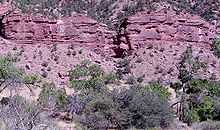Moenave Formation
| Moenave Formation Stratigraphic range: Mesozoic | |
|---|---|
| Type | Geological formation |
| Unit of | Glen Canyon Group |
| Lithology | |
| Primary | siltstone and sandstone |
The Moenave Formation is a Mesozoic geologic formation, in the Glen Canyon Group. It is found in Utah and Arizona.
The Moenave was deposited on an erosion surface on the Chinle Formation following an early Jurassic uplift and unconformity that represents about ten million years of missing sedimentation.[1] Periodic incursions of shallow seas from the north during the Jurassic flooded parts of Wyoming, Montana, and a northeast–southwest trending trough on the Utah/Idaho border.[2] The Moenave was deposited in a variety of river, lake, and flood-plain environments.[1]

The oldest beds of this formation belong to the Dinosaur Canyon Member, a reddish, slope-forming rock layer with thin beds of siltstone that are interbedded with mudstone and fine sandstone.[3] The Dinosaur Canyon, with a local thickness of 140 to 375 feet (43 to 114 m), was probably laid down in slow-moving streams, ponds and large lakes.[4] Evidence for this is in cross-bedding of the sediments and large numbers of fish fossils.
The upper member of the Moenave is the pale reddish-brown with a thickness of 75 to 150 feet (23 to 46 m) and cliff-forming Springdale Sandstone.[4] It was deposited in swifter, larger, and more voluminous streams than the older Dinosaur Canyon Member.[3] Fossils of large sturgeon-like freshwater fish have been found in the beds of the Springdale Sandstone.[3] The next member in the Moenave Formation is the thin-bedded Whitmore Point, which is made of mudstone and shale.[3] The lower red cliffs visible from the Zion Human History Museum (until 2000 the Zion Canyon Visitor Center) are accessible examples of this formation.[5]
Fossils
Dinosaur remains are among the fossils that have been recovered from the formation, although none have yet been referred to a specific genus.[6]
Glen Canyon Group
The 4 members of the Glen Canyon Group, from youngest (top member) to oldest (bottom member), are:
- Navajo Sandstone — early Jurassic [7]
- Kayenta Formation — early Jurassic [8]
- Moenave Formation — early Jurassic
- Wingate Sandstone — early Jurassic [9]
See also
- List of dinosaur-bearing rock formations
- List of stratigraphic units with indeterminate dinosaur fossils
References
- ↑ 1.0 1.1 Biek, Robert F.; Grant C. Willis, Micheal D. Hylland, and Hellmut H. Doelling (August 2003). "Geology of Zion National Park, Utah". In Paul B. Anderson (editor). Geology of Utah's Parks and Monuments. Bryce Canyon Natural History Association and Utah Geological Association. ISBN 1-882054-10-5
- ↑ Graham, J. (2006). Zion National Park Geologic Resource Evaluation Report (PDF). Denver, Colorado: National Park Service. pp. 27–35. Natural Resource Report NPS/NRPC/GRD/NRR—2006/014. Retrieved 2008-08-13.
- ↑ 3.0 3.1 3.2 3.3 Harris, Ann G.; Tuttle, Esther; Tuttle, Sherwood D. (1997). Geology of National Parks (5th ed. ed.). Iowa: Kendall/Hunt Publishing. pp. 30–42. ISBN 0-7872-5353-7.
- ↑ 4.0 4.1 GORP contributors. "Zion National Park Geology". GORP / Orbitz Away LLC. Retrieved 2008-08-11.
- ↑ NPS contributors. "Zion: Geologic Formations". National Park Service. Retrieved 2013-11-12.
- ↑ Weishampel, et al. (2004). "Dinosaur distribution." Pp. 517-607.
- ↑ Anonymous (2011b) Navajo Sandstone, Stratigraphy of the Parks of the Colorado Plateau. U.S. Geological Survey, Reston, Virginia. last accessed August 18, 2013
- ↑ Weishampel, David B; et al. (2004). "Dinosaur distribution (Early Jurassic, North America)." In: Weishampel, David B.; Dodson, Peter; and Osmólska, Halszka (eds.): The Dinosauria, 2nd, Berkeley: University of California Press. Pp. 530-532. ISBN 0-520-24209-2.
- ↑ Lucas, S. G., A. B. Heckert, J. W. Estep, and O. J. Anderson. 1997. Stratigraphy, biostratigraphy, and sequence stratigraphy of the Upper Triassic Chinle Group, Four Corners region. Pages 81-107 in Anderson, O. J., B. Kues, and S. G. Lucas, editors. Mesozoic geology and paleontology of the Four Corners Region. New Mexico Geological Society, Socorro, NM. New Mexico Geological Society, 48th Field Conference.
- Weishampel, David B.; Dodson, Peter; and Osmólska, Halszka (eds.): The Dinosauria, 2nd, Berkeley: University of California Press. 861 pp. ISBN 0-520-24209-2.
| Wikimedia Commons has media related to Moenave Formation. |